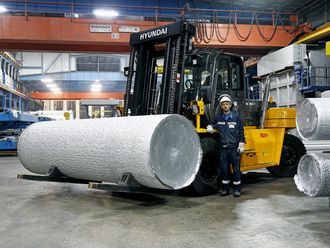
Dubai: Taking direct control of the wheel is starting to work well for Nissan’s fortunes in Saudi Arabia. It is just over a year and more that the Middle East operations of the auto manufacturer set up a company in Saudi Arabia to handle all distribution requirements as well as confirming a second dealership. That effort is showing up in the numbers.
“If by the 2015 financial year (for Japanese companies that would be the 12-month period up to March 31) we end up doing 60,000 units in Saudi Arabia that should push into the third or fourth position there,” said Samir Cherfan, Managing Director at Nissan Middle East. “We are starting to break the wall in getting more Saudi buyers driving Nissan models and pushing past the 40,000 units mark.
“As important as having the points-of-sale located in all key regions of the kingdom, we had to work hard on getting the aftermarket facilities and parts availability in good order. That’s also starting to happen now, with the new dealer acquiring existing facilities or building new ones. I think we are reaching 90 per cent market coverage with all the new point-of-sales. We are also doing good on parts availability which had clearly been a challenge for the brand in the past and had harmed its chances.”
Nissan, incidentally, was a market leader in the kingdom in the 1980s.
It is clear why Saudi Arabia is central to Nissan’s — and for that matter any auto manufacturers’ — regional ambitions. It easily accounts for highest volumes annually, upwards of 500,000 units and more as against the UAE’s 300,000 units plus. The demographic mix, with its heavy youth orientation and who have a penchant for wheels, is another compelling reason why carmakers have to go the extra mile to get things right.
Currently, Toyota owns a 40 per cent share of the new vehicle volumes, with Hyundai and General Motors in close competition for the next two spots. “If we get everything right, it’s possible that Nissan volumes could get to be in the 100,000 unit levels in the future,” said Cherfan. “The line-up now is one of the youngest Nissan has had for some time — we have either introduced a new model or extensively refreshed a popular one.
“With an expanded line-up — five new models within financial year 2016 — there will be a serious challenge to Toyota’s position in the kingdom and in others as well.”
Nissan has set a target of 256,000 units from the Gulf markets for financial year 2016 from the 128,000 units in FY2013. “As of now, the overall market’s been growing at 7 per cent and we are growing at three times that,” said Cherfan. “Patrol sales after the launch of the latest version now tops 35,000 from the 10,000 it had been doing, and the new Sunny, X-Trail, are doing their part.
“I believe, barring some niches, Nissan today has a model for any user’s needs. And in the next six years, the stated plan is to have 52 models. We are getting there.”
Japanese makers will also be looking to coast on the favourable yen-dollar exchange rates in vogue. According to local market sources, they gain a definite advantage when prices are being quoted for corporate fleet sales or lease renewals.
But Cherfan has his eyes on the bigger picture — “Hopefully, the favourable situation will prevail over the yen — clearly it will be a big help on our parts pricing as these are mostly shipped in from plants in Japan. But with the existing vehicles, we have had a multi-market sourcing for some time now and not wholly reliant on the Japanese plants.”











